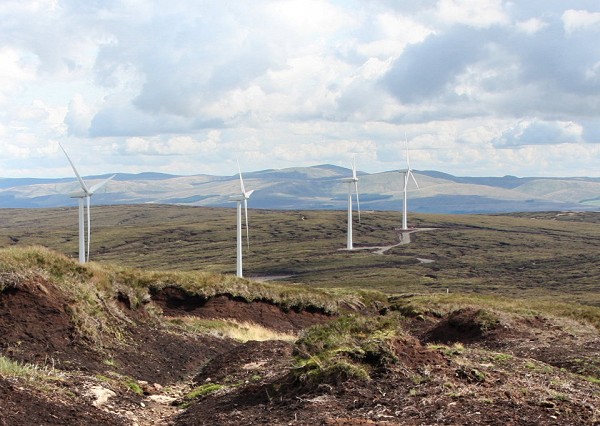
A house builder would be unlikely to apply for permission to add a loft conversion before even digging the foundations of the building, but it seems some power companies see no problem in this kind of behaviour.
In recent weeks the Mountaineering Council of Scotland (MCofS) and landscape conservation charity the John Muir Trust (JMT) have issued separate responses to planning applications. Each concerns a different wind farm in Scotland, but common to both cases is a planning ploy they say developers are using.
'I am increasingly seeing applications for extension when the orginial consented development has yet to be built - effectively a larger development by the back door'
Each of the two companies involved has already received planning consent for a wind farm of a certain size, but each have now made a further application that would increase the scale of the projects. In one case, a windfarm at Calliachar, developer SSE now wants to increase the diameter of their turbines, while the other developer Infinergy seeks to extend the area covered by their wind farm at Lochluichart. In neither case has the original already-consented project even been built yet. Given the timescales and sums involved developers are unlikely to be making snap decisions, so the inevitable suspicion in some quarters is that these multi-stage planning applications are part of a considered policy, an attempt to squeeze larger developments through the planning process in incremental stages.
To what extent is the planning system being manipulated? And if it is, is this less than up-front approach becoming something of a trend?
'I am increasingly seeing applications for extension when the orginial consented development has yet to be built - effectively a larger development by the back door' says Hebe Carus, Access and Conservation Officer at the MCofS.
Lochluichart Extension
The proposal to which the MCofS has responded is a plan by Infinergy, currently at the draft stage, to extend the Lochluichart wind farm. Since the site is near Ben Wyvis and will be prominently visible from several high quality hills in a wild part of the highlands the original project inevitably attracted controversy, and its size had to be scaled down before planning consent was granted. Critics now point out that the new proposal to extend a wind farm consented but not yet built would effectively amount to a scheme similar to the original pre-revision proposal.
The MCofS response document, submitted to the Scottish Government says:
'[we are] gravely concerned that this is not an appropriate time to assess an extension application. This is due to the fact that the original development has yet to be built and because the impact of this extension is greatly dependent upon the outcome of the Corriemoillie Judicial Review as Lochluichart, the extension and [neighbouring development] Corriemoillie would effectively be viewed as a single development. Additionally, the MCofS objects to the practice of applying for an extension before construction of the original consent. This practice effectively renders the original and extension developments as one, and as such should be applied for as one development and considered as a whole. An environmental impact assessment is an extrapolation and an estimate of expected impact.'
'Many local communities, and indeed land owners, near wind farm development sites have reported that the development once built had far greater impact than was envisaged from the Environmental Statement. Attempting to assess the potential impact of a development based on the context that does not currently exist is an extremely imprecise science. The MCofS strongly believes that for an assessment to reasonably confidently project impact of an extension the original application proposal must be built already, giving an opportunity for assessment of an extension to be assessed based on the actual context rather than adding an estimate on top of another estimate. On this basis we object to the extension proposal and believe it should be required to be re-submitted after the original wind farm is operational, else it is a larger original proposal by the back door.'
'The MCofS objects to the fact that the area of turbines that were removed from the original application in order to achieve consent were in the same area as the proposed Extension turbines. We consider that little has changed in the situation in the intervening few years and the assessment does not show that what was not acceptable then is acceptable now. In actuality, there is a greater cumulative impact with other consented / proposed developments that have been applied for in the interim.'
In a nutshell, here's how The MCofS summarise their position (the full document can be read here):
'It may seem that responding to a small extension (6 turbines in this case) is a bit like trying to constrain a horse after it has bolted, however it is important to keep in the minds of Ministers (who will decide this case) that this is in prime mountaineering environment and that incremental increases are not non-significant. This development is right next to the Lochluichart wind farm (consented but not built) and the Corriemoillie wind farm (in Judicial Review)[...] In principle is it really an extension when the original wind farm has not been built and the turbines that were removed in the plans to get that development consented are in the same area as those applied for in the extension?'.
'If it was clear that an original development could not sustain any further development around it, either in landscape or other terms, it would not be in the interests of the developer to invest in another application'
Critics might suggest that incremental extensions of this sort amount to an attempt to sneak a bigger development through the back door, but Fiona Milligan of Infinergy has little time for this charge.
'We believe it is an unfair assumption to make' she tells us.
'I'm not sure that it's 'easier' to get an extension once a scheme has consent, particularly as any extension has to go through the full [planning] process, but it can make more sense from a landscape point of view (if the capacity is there) to extend one rather than having a completely separate one near-by, which would impact on visual amenity far more.
'An extension of any type will only be proposed by a developer when it is clear that the landscape has the capacity to support further development, alongside the range of other environmental assessments that must take place including (but not only) ecological, bird and hydrology surveys. Each application must be assessed as a stand alone development as well as cumulatively with neighbouring developments. If it was clear that an original development could not sustain any further development around it, either in landscape or other terms, it would not be in the interests of the developer to invest in another application.'
But 'clear' two whom, it might be asked? The disagreement between developers and conservationists hinges on this question. It is not for one side or the other to dictate the answer in advance; that's what the planning process is for.
Is the proposed extension something that Infinergy have just suddenly thought of, or does it form part of a long-considered strategy?
'We believed that Lochluichart could support a larger development at the outset, and this view has been strengthened by the approval of the neighbouring Corriemoillie Wind Farm proposal by The Highland Council in March this year' says Milligan. 'Lochluichart Wind Farm Extension 'completes' the overall development of both of these schemes together, particularly in design, landscape and visual terms.'
'Infinergy took the view, based on an assessment by an independent landscape consultant, that there is enough landscape capacity to absorb a 6 turbine wind farm extension to the original Lochluichart scheme. When the initial proposal was announced for the Lochluichart Extension a total of 13 turbines were proposed, this proposal has been scaled back significantly to the 6 turbine scheme which Infinergy have submitted based on feedback from consultees such as The Highland Council (THC) and Scottish Natural Heritage (SNH).'
The company also take issue with the suggestion that the sum of the consented part and the proposed extension equals something closely resembling their original vision of a much bigger windfarm on the site.
'The original application for Lochluichart (submitted in November 2005) was for a 43 turbine scheme, the amended scheme which achieved planning consent was for 17 turbines. The submitted Lochluichart Wind Farm Extension is for 6 turbines. There are dramatic differences therefore between the original Lochluichart scheme layout and that which Infinergy have submitted to be determined for Lochluichart Extension as a section 36 application by the Scottish Government.'
'At every stage of the development process a responsible wind farm developer will respond to feedback from consultees in amending a wind farm scheme layout in terms of number of turbines, turbine height and turbine location as part of the site iteration process and will, in some instances, abandon plans if it is considered there is no longer a viable wind farm project' says Milligan. 'Only by listening, and taking on board such comments and reacting to them in amending a proposal, do proposed wind farm projects gain planning consent.'
So how can planners be expected to properly assess the likely impact of Infinergy's extension plan if the already-consented part of the project has not even been built yet?
'Planners in both local authorities and at Government level have within their teams of expertise professional landscape architects. Their role within development and assessment teams is to judge the extent of the impacts a development has within a particular landscape. They do this using a variety of tools and methodologies as well as their own professional experience coupled with national guidance and site visits to determine how one or more developments will fit within a landscape. They do not need to see a fully developed site to understand the impacts it and others might have.'
Calliachar
Meanwhile over in Perthshire the JMT have raised concernes about the 14-turbine Calliachar windfarm on moorland near Aberfeldy, sumbitting an objection to Perth and Kinross Council to plans by Scottish & Southern Electricity (SSE) to increase the height of turbines at the wind development before construction has even started, from the 100m that was consented to a new height of to 110m.
'Developers are using the planning process as a game, where they get as much as they can in the first round, then come back and back again. If SSE significantly change their plans before a sod is turned with no real scrutiny it makes a mockery of the planning process'
In 2010 SSE purchased Calliachar from I & H Brown, after it had been considered at a controversial Public Local Inquiry and then consented by the Scottish Government. During the initial planning process the JMT and others were told by I&H Brown that the application was for 100m high turbines only, due to the impact that larger ones would have on the landscape. Although SSE already has consent to build Calliachar this consent is for 100m high turbines only; the new proposal to build bigger will have to go through the planning process too. But now that planners have already agreed to a wind farm here, will the size increase be more likely to gain consent than an original application to build 110m turbines might have been? Is this a calculated move from SSE?
Even at 100m the landscape impact will be felt.
'These turbines, along with the neighbouring 68-turbine Griffin development and a number of the massive pylons forming the Beauly-Denny power line, will be visible from iconic areas of wild land such as the summit of Schiehallion , one of Scotland's most popular hills' says a JMT statement.
Helen McDade, head of policy for the JMT, goes on:
'A 10 per cent increase in height translates to a 28 per cent increase in the area covered by the blades. This means the turbines will be even more prominent in the landscape.'
'There is a major risk that Highland Perthshire will become known not for its beautiful natural landscapes but as an industrialised area that people who wish to experience the peace of nature rush through to get further north in search of wild places.'
This is a well rehearsed argument familiar to anyone with an interest in the British hills, but what she says next is more pertintent to the issue of questionable planning practises:
'Developers are using the planning process as a game, where they get as much as they can in the first round, then come back and back again. If SSE can come back after the whole planning process, including a Public Local Inquiry, and significantly change their plans before a sod is turned with no real scrutiny, it makes a mockery of the planning process. For this reason alone, the application should be turned down.'
'Even the Scottish Government itself stated, when consenting Calliachar, that, ".... The development will have a significant adverse effect on local tourism and recreation mitigation proposals are necessary to offset this effect to an acceptable degree." Surely, they can't now allow even worse impacts?'
The JMT's full response to the Calliachar plan is published on their website.
SSE were unavailable for comment.
Both sides in the wind farm development debate are wont to complain that Scotland's planning regime is stacked in favour of the opposition. They can't both be right of course, and defenders of planning's neutrality (if such exist) might even claim that both are wrong. But whatever its faults and merits when the system is working as intended, it seems clear that as long as loopholes exist then developers will find them. The tactic of staggered planning applications may be just such a loophole; to some it looks slightly dodgy, while for others it's just good business.













Comments